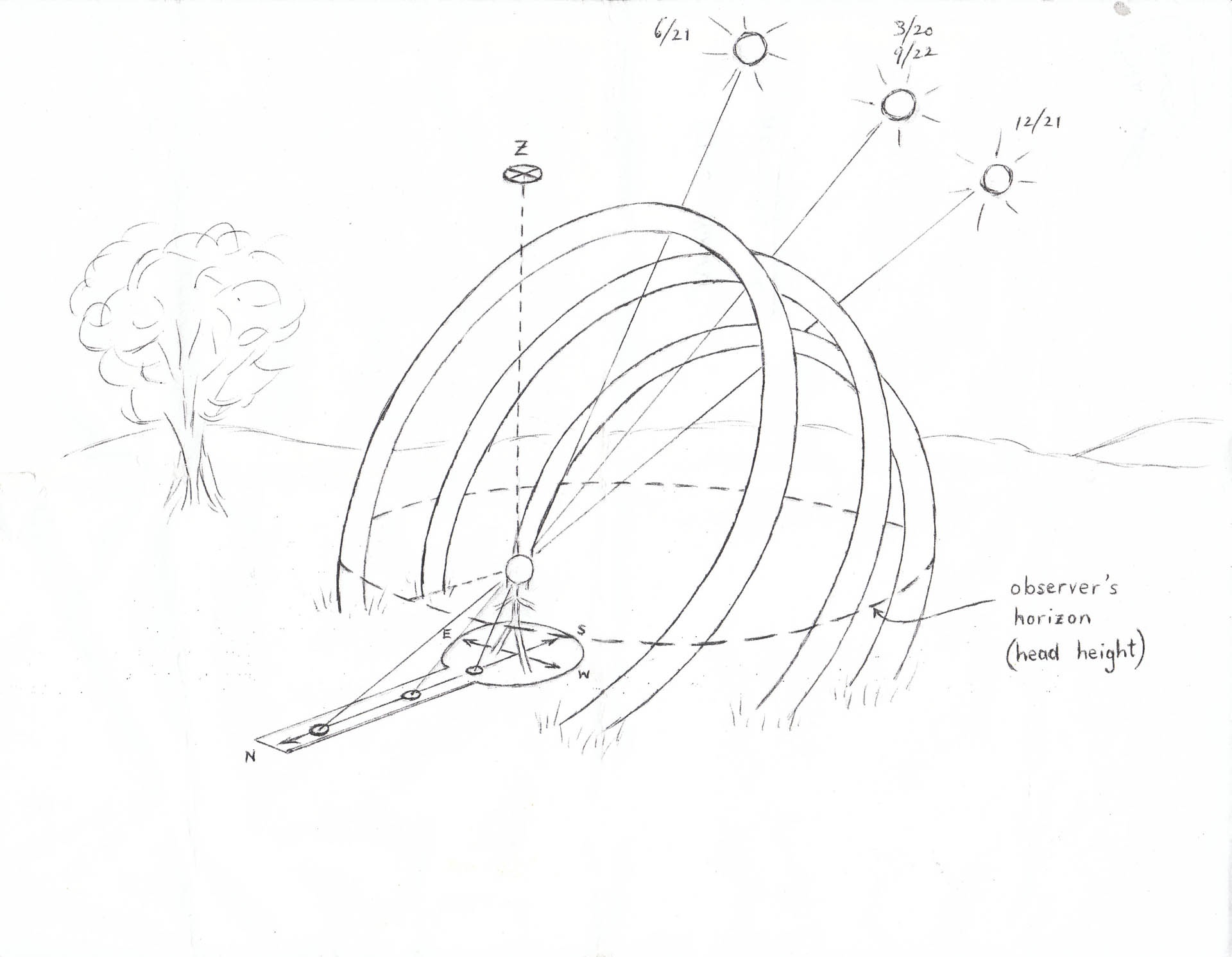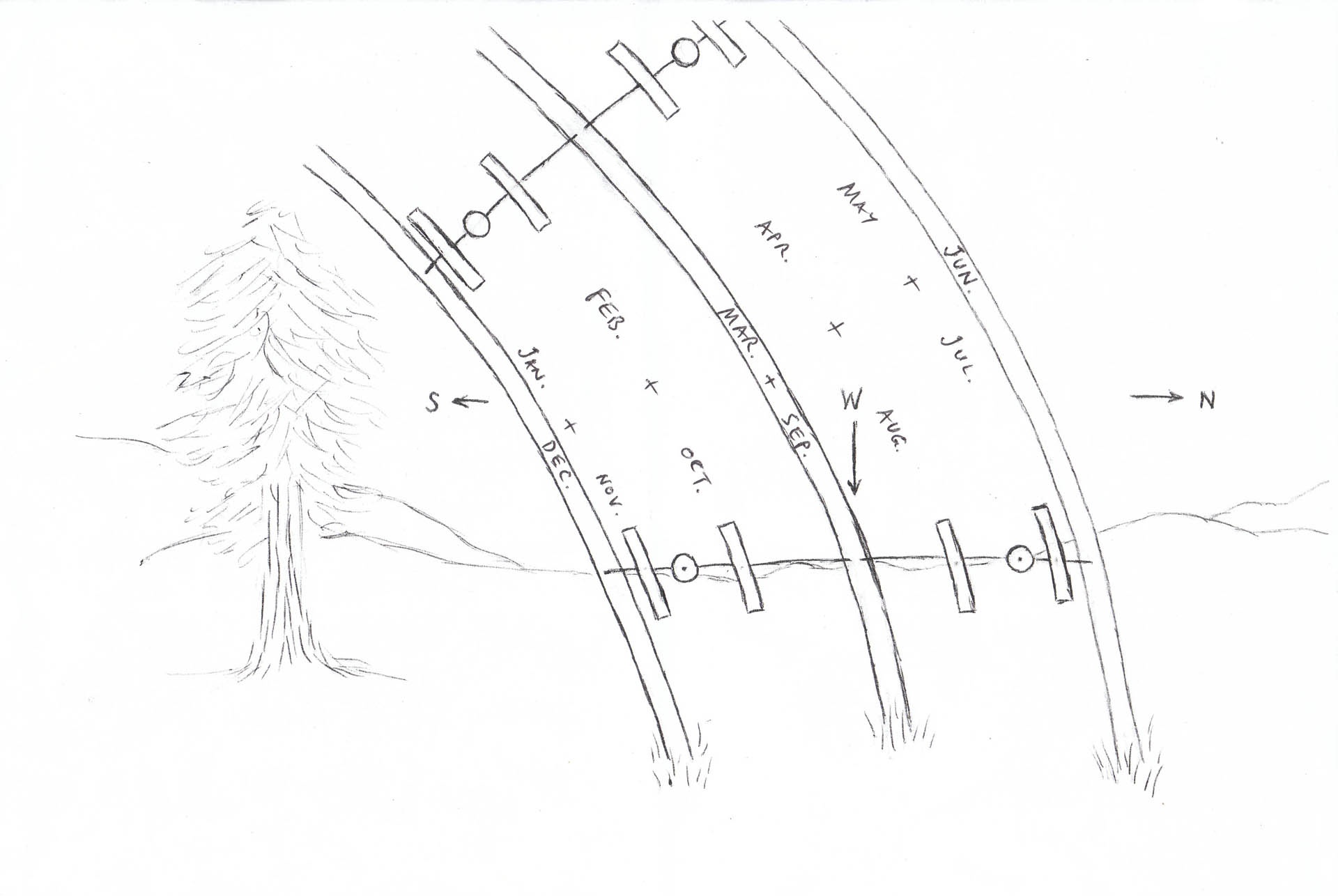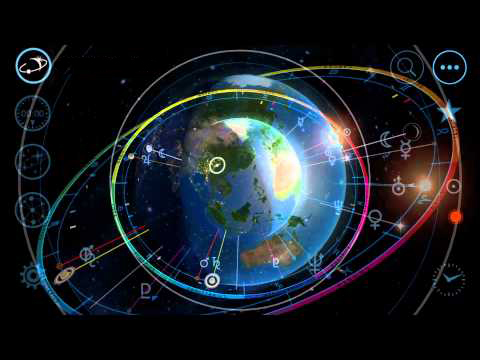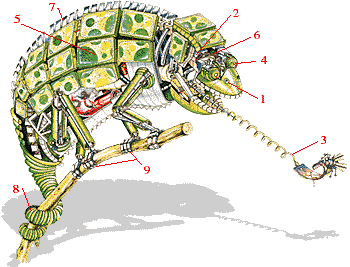“Solar Window” on the Sky

This large steel sculpture piece is designed to highlight the connections between earth and sky, tracing out the arcs of the sun’s apparent motion across the sky on a set of key days of the year (two equinoxes and two solstices). Its overall appearance would be a bit reminiscent of parallel ribs in a whale skeleton – all tilted toward the south at an angle from the vertical plane equal to our latitude at this location on the planet. Park visitors would be able to stand at the central point and look out to see the sky “gridded” with this “cage” of parallel arcs, and on any one of the appropriate days of the year could actually watch as the sun appears to move along behind the arc that traces the sun’s path for that corresponding day. On days other than our key days, the sun would be shining through and moving along the bands of sky between these arcs; one would be able to note and keep track of the yearly progress of the sun’s daily east-west arcs as they wind their way gradually around a northward or southward spiral, depending on the time of year. (Warnings in signage at the site would remind people of the dangers of looking directly at the sun, of course.) This is essentially a modern-day “Steelhenge” (“Skyhenge”?), a sort of sun-dial or solar calendar in the sky. (The pattern of the three arcs is an exact mapping of the belt of the tropics on the earth, writ large out onto the sky. The center arc, for the equinoxes, shows the set of all points in our sky that are overhead at the equator. The two outer arcs running along parallel to the center arc, north and south of it, show all points overhead at the Tropic of Cancer and Tropic of Capricorn, corresponding to our summer and winter solstices, respectively. The entire set of arcs spans the “solar window” as seen from our latitude: the swath of sky containing all celestial points where the sun can ever be seen from here.)
Supplementing our three structurally engineered arcs are cross-pieces serving as “vernier scales” of sorts, oriented at right angles to the band of arcs and showing small portions of the arcs corresponding to other days of the year – one for each month as well as one for each of the four “cross-quarter” days (points midway between an equinox and a solstice). There are five of these placed along the band of arcs: one connecting across the highest points of the arcs (due south, running vertically along the north-south meridian, marking solar noon for every day), one each marking the sunrise and sunset points along the eastern and western horizons, and one along each side at the halfway point between these highest and lowest points for the sun. A small cross (+) in a circle marks the zenith point directly above the observer.
A strip of smooth stone running along the ground, straight northward from where the observer stands, has several inlaid metallic or crystalline circular markers showing the locations of the shadows of the center points of the arcs (right at their intersections with the central “vernier” cross-piece there at due south and solar noon) that will be cast by the sun on our key days, directly along the observer’s line of sight to the sun at those key times. The shadows of these points will coincide exactly with the shadows at those times of the head of the observer viewing from a polished-stone compass rose at the central point of this sculpture.
The location for this piece within the Chanticleer Park, as that park is presently conceived, would probably best be in the “informal turf area” – but we are open to any other possibilities that may arise as plans for this park evolve. The dimension of the sculpture as proposed here (diameter of the largest of the circular partial rings – the center one corresponding to the equinoxes) is 25 feet. For this concept, the larger the dimensions, the better, to minimize the effect of observer parallax – i.e., the sensitivity of what is observed to the position of the observer. If the sun’s paths across the sky are to be properly lined up with our arcs from an observer’s point of view, then the smaller such a piece is, the more severe the limitations on where the observer’s eyes must be. The (non-stainless) steel in this structure will be painted (gold, for the sun!), to guard against rusting. The ends of the arcs will be securely embedded in concrete foundation work.

A nice connection to the farm history at this site is provided by the theme of the sun, with its seasonal cycles, as source of life and energy on earth. Growers of food crops over the millennia have tracked the sun’s motions so they could organize their planting and harvesting times. Far away from Stonehenge, an amazing example of this kind of “sky intelligence” is found high atop a mesa in the Chaco Canyon region of the American southwest, with carved spirals on the side of a cliff and “sun daggers” of light that appeared between shadows and speared or straddled the centers of the spirals at solar noon on key dates of the year. As the sun is by far our dominant source of energy on this planet, and we urgently need to dramatically increase our utilization of this vast resource of clean “sky power”, we need such artworks again —for the modern age— to encourage much greater awareness of all aspects of our relationship to our parent star.
 Wednesday, January 25, 2017
Wednesday, January 25, 2017  Planet Watch with Cosmic Joe Jordan and Rachael Goodman Sundays KSCO 2 p.m.
Planet Watch with Cosmic Joe Jordan and Rachael Goodman Sundays KSCO 2 p.m. Elon Musk,
Elon Musk,  Joe Jordan,
Joe Jordan,  Rachael Ann Goodman,
Rachael Ann Goodman,  future news,
future news,  trump in
trump in  interview
interview 



